Numerical Analyses on the Behavior of Geosynthetic-Reinforced Soil: Integral Bridge and Integrated Bridge System
Abstract
:1. Introduction
2. Numerical Modelling Using Plaxis 2D
2.1. Description of the Bridge Models
2.1.1. GRS-IBS Model Design
2.1.2. GRS-IB Model Design
2.1.3. IB Model Design
2.2. Geometry Configuration of Each Model Case
2.3. Material Input Parameters
2.3.1. Soil Material Input Parameters
2.3.2. Wall Facing Materials’ Input Parameters
2.3.3. Reinforcement Materials’ Input Parameters
2.3.4. Loading Conditions
2.3.5. Phase Construction of the Numerical Models
- For Case 1: The first layer of backfill lift is activated, which includes the equivalent height of the gravel bags, soil backfill, reinforcement, and interfaces. The same procedure is repeated until the full height of the wall abutment is reached. The GRS wall has to be completed before the FHR facing. Thus, at this point, the dead load representing the approach backfill shall be activated. Then, the integral bridge is activated, including the dead load representing the girder.
- For Case 2: The first layer of backfill lift is activated, which includes the CMU block facing, soil backfill, reinforcement, and interfaces. The same procedure is repeated until the full height of the wall abutment is reached. At the end of the bridge construction, the dead load representing the girder and approach backfill is activated.
- For Case 3: This case is different from the other two cases because it has no GRS abutment. Here, the integral bridge is activated first, including the equivalent dead load representing the girder. Then, the first layer of the soil backfill is activated. The same procedure is repeated until the full height of the wall abutment is reached. At the end of the bridge construction, the dead load representing the approach backfill is activated.
3. Numerical Analysis Results and Discussion under Static Loading
3.1. Lateral Displacements at Wall Facing
3.1.1. Effects of Wall Facing Type and Construction on Lateral Displacements at Wall Facing
3.1.2. Effects of Surcharge Loads on Lateral Displacements at the Wall Facing
3.2. Vertical Displacements at the Top of the Wall Abutment
3.2.1. Effects of the Wall Facing Type and Construction on Vertical Displacements at the Top of the Wall Abutment
3.2.2. Vertical Displacement Increments at the Top of the Wall Abutment due to Applied Loadings
3.3. Lateral Stresses behind the Wall Facing
3.4. GRS Wall Potential Failure Surfaces and Reinforcement Behavior
3.4.1. Location of Potential Failure Surfaces in the GRS Wall
3.4.2. Reinforcement Behavior
4. Numerical Analysis Results and Discussion under Dynamic Loading
5. Conclusions
- Generally, the numerical results showed that the GRS-IB technology performed better than the GRS-IBS and IB technologies considering the internal and external behavior of the numerical models when subjected to static and dynamic loads.
- The GRS-IB numerical models exhibited satisfactory and stable behavior when subjected to static and dynamic loads.
Author Contributions
Funding
Institutional Review Board Statement
Informed Consent Statement
Data Availability Statement
Conflicts of Interest
References
- Adams, M.; Nicks, J.; Stabile, T.; Wu, J.; Schlatter, W.; Hartmann, J. Geosynthetic Reinforced Soil Integrated Bridge System, Synthesis Report (FHWA-HRT-11-027); Federal Highway Administration U.S. Department of Transportation: Washington, DC, USA, 2011.
- Holtz, R.D. 46th Terzaghi lecture: Geosynthetic reinforced soil: From the experimental to the familiar. J. Geotech. Geoenviron. Eng. 2017, 143, 03117001. [Google Scholar] [CrossRef]
- Jones, C.J.F.P. Earth Reinforcement and Soil Structures; Butterworth’s Advanced Series in Geotechnical Engineering; Butterworth-Heinemann: Oxford, UK, 1985. [Google Scholar]
- Berg, R.R.; Christopher, B.R.; Samtani, N.C. Design of Mechanically Stabilized Earth Walls and Reinforced Soil Slopes; Volume I (FHWA-NHI-10-024 FHWA GEC 011-Vol I); National Highway Institute, Federal Highway Administration, U.S. Department of Transportation: Washington, DC, USA, 2009.
- Koerner, R.M.; Koerner, G.R. The importance of drainage control for geosynthetic reinforced mechanically stabilized earth walls. J. GeoEng. 2011, 6, 3–13. [Google Scholar]
- Koerner, R.M.; Koerner, G.R. A data base, statistics and recommendations regarding 171 failed geosynthetic reinforced mechanically stabilized earth (MSE) walls. Geotext. Geomembr. 2013, 40, 20–27. [Google Scholar] [CrossRef]
- Shin, E.C.; Cho, S.D.; Lee, K.W. Case study of reinforced earth wall failure during extreme rainfall. In Proceedings of the TC 302 Symposium: International Symposium on Backward Problems in Geotechnical Engineering and Monitoring of Geo-Construction, Osaka, Japan, 14–15 July 2011; pp. 146–153. [Google Scholar]
- Adams, M.; Nicks, J.; Stabile, T.; Wu, J.; Schlatter, W.; Hartmann, J. Geosynthetic Reinforced Soil Integrated Bridge System Interim Implementation Guide (FHWA-HRT-11-026); Federal Highway Administration U.S. Department of Transportation: Washington, DC, USA, 2012.
- Tatsuoka, F.; Tateyama, M.; Koda, M.; Kojima, K.; Yonezawa, T.; Shindo, Y.; Amai, S. Recent research and practice of GRS integral bridges for railways in Japan. Jpn. Geotech. Soc. Spec. Publ. 2016, 2, 2307–2312. [Google Scholar] [CrossRef] [Green Version]
- Tatsuoka, F.; Tateyama, M.; Koseki, J.; Yonezawa, T. Geosynthetic-reinforced soil structures for railways in Japan. Transp. Infrastruct. Geotechnol. 2014, 1, 3–53. [Google Scholar] [CrossRef] [Green Version]
- Tatsuoka, F.; Tateyama, M.; Mohri, Y.; Matsushima, K. Remedial treatment of soil structures using geosynthetics-reinforcing technology. Geotext. Geomembr. 2007, 25, 204–220. [Google Scholar] [CrossRef]
- Tatsuoka, F.; Tateyama, M.; Uchimura, T.; Koseki, J. Geosynthetic-reinforced soil retaining walls as important permanent structures. Geosynth. Int. 1997, 4, 81–136. [Google Scholar] [CrossRef]
- Koda, M.; Nonaka, T.; Suga, M.; Kuriyama, M.; Tateyama, M.; Tatsuoka, F. A Series of Lateral Loading Tests on a Full-Scale Model of Geosynthetic-Reinforced Soil Integral Bridge. In Proceedings of the International Symposium on Design and Practice of Geosynthetic-Reinforced Soil Structures, Bologna, Italy, 11–16 October 2013; pp. 157–174. [Google Scholar]
- Yazaki, S.; Tatsuoka, F.; Tateyama, M.; Koda, M.; Watanabe, K.; Duttine, A. Seismic design of GRS integral bridge. In Proceedings of the International Symposium on Design and Practice of Geosynthetic-Reinforced Soil Structures, Bologna, Italy, 11–16 October 2013; pp. 142–156. [Google Scholar]
- Ardah, A.; Abu-Farsakh, M.; Voyiadjis, G. Numerical evaluation of the performance of a Geosynthetic Reinforced Soil-Integrated Bridge System (GRS-IBS) under different loading conditions. Geotext. Geomembr. 2017, 45, 558–569. [Google Scholar] [CrossRef]
- Lenart, S.; Kralj, M.; Medved, S.P.; Suler, J. Design and construction of the first GRS integrated bridge with FHR facings in Europe. Transp. Geotech. 2016, 8, 26–34. [Google Scholar] [CrossRef]
- Das, B.M. Principles of Foundation Engineering, 7th ed.; Cengage Learning: Stamford, CT, USA, 2012. [Google Scholar]
- Murthy, V.N.S. Geotechnical Engineering: Principles and Practices of Soil Mechanics and Foundation Engineering; CRC Press: Boca Raton, FL, USA, 2002. [Google Scholar]
- Abu-Farsakh, M.; Ardah, A.; Voyiadjis, G. 3D Finite element analysis of the geosynthetic reinforced soil-integrated bridge system (GRS-IBS) under different loading conditions. Transp. Geotech. 2018, 15, 70–83. [Google Scholar] [CrossRef]
- Abu-Farsakh, M.; Ardah, A.; Voyiadjis, G. Numerical parametric study to evaluate the performance of a Geosynthetic Reinforced Soil–Integrated Bridge System (GRS-IBS) under service loading. Transp. Geotech. 2019, 20, 100238. [Google Scholar] [CrossRef]
- Ardah, A.; Abu-Farsakh, M.; Voyiadjis, G. Numerical parametric study of geosynthetic reinforced soil integrated bridge system (GRS-IBS). Geotext. Geomembr. 2021, 49, 289–303. [Google Scholar] [CrossRef]
- Zheng, Y.; Fox, P.J. Numerical investigation of the geosynthetic reinforced soil–integrated bridge system under static loading. J. Geotech. Geoenviron. Eng. 2017, 143, 04017008. [Google Scholar] [CrossRef]
- Plaxis BV. Plaxis 2D Reference Manual; Plaxis B.V.: Delft, The Netherlands, 2018. [Google Scholar]
- Plaxis BV. Plaxis 2D Tutorial Manual; Plaxis B.V.: Delft, The Netherlands, 2018. [Google Scholar]
- Damians, I.P.; Bathurst, R.J.; Josa, A.; Lloret, A.; Albuquerque, P.J.R. Vertical facing loads in steel reinforced soil walls. J. Geotech. Geoenviron. Eng. 2013, 139, 1419–1432. [Google Scholar] [CrossRef]
- Damians, I.P.; Bathurst, R.J.; Josa, A.; Lloret, A. Numerical analysis of an instrumented steel-reinforced soil wall. Int. J. Geomech. 2015, 15, 1–15. [Google Scholar] [CrossRef]
- Damians, I.P.; Bathurst, R.J.; Lloret, A.; Josa, A. Vertical facing panel-joint gap analysis for steel-reinforced soil walls. Int. J. Geomech. 2016, 16, 04015103. [Google Scholar] [CrossRef] [Green Version]
- Yu, Y.; Bathurst, R.J.; Allen, T.M.; Nelson, R. Physical and numerical modelling of a geogrid reinforced incremental concrete panel retaining wall. Can. Geotech. J. 2016, 53, 1883–1901. [Google Scholar] [CrossRef]
- Yu, Y.; Bathurst, R.J. Influence of selection of soil and interface properties on numerical results of two soil geosynthetic interaction problems. Int. J. Geomech. 2017, 17, 04016136. [Google Scholar] [CrossRef]
- Yu, Y.; Bathurst, R.J.; Miyata, Y. Numerical analysis of mechanically stabilized earth wall reinforced with steel strips. Soils Found. 2015, 55, 536–547. [Google Scholar] [CrossRef]
- Visone, C.; Santucci de Magistris, F. Some Aspects of Seismic Design Methods for Flexible Earth Retaining Structures. Workshop of ERTC12–Evaluation Committee for the Application of EC8 Special Session XIV ECSMGE, Madrid, Patron Ed., Bologna. 2007. Available online: http://www.reluis.it/doc/pdf/Pubblicazioni/vissao.pdf (accessed on 8 April 2021).
- Wu, J.T.H. Lateral earth pressure against the facing of segmental GRS walls. In Geosynthetics in Reinforcement and Hydraulic Applications (GSP 165); Gabr, B., Ed.; ASCE: Reston, VA, USA, 2007; pp. 165–175. [Google Scholar]

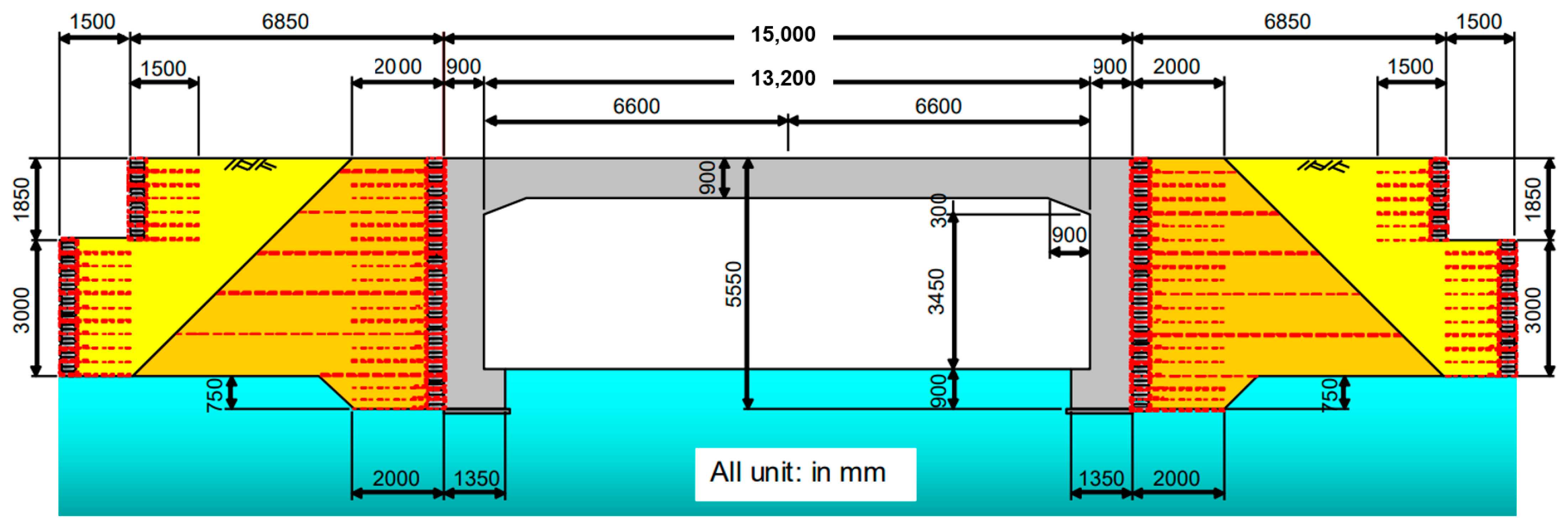
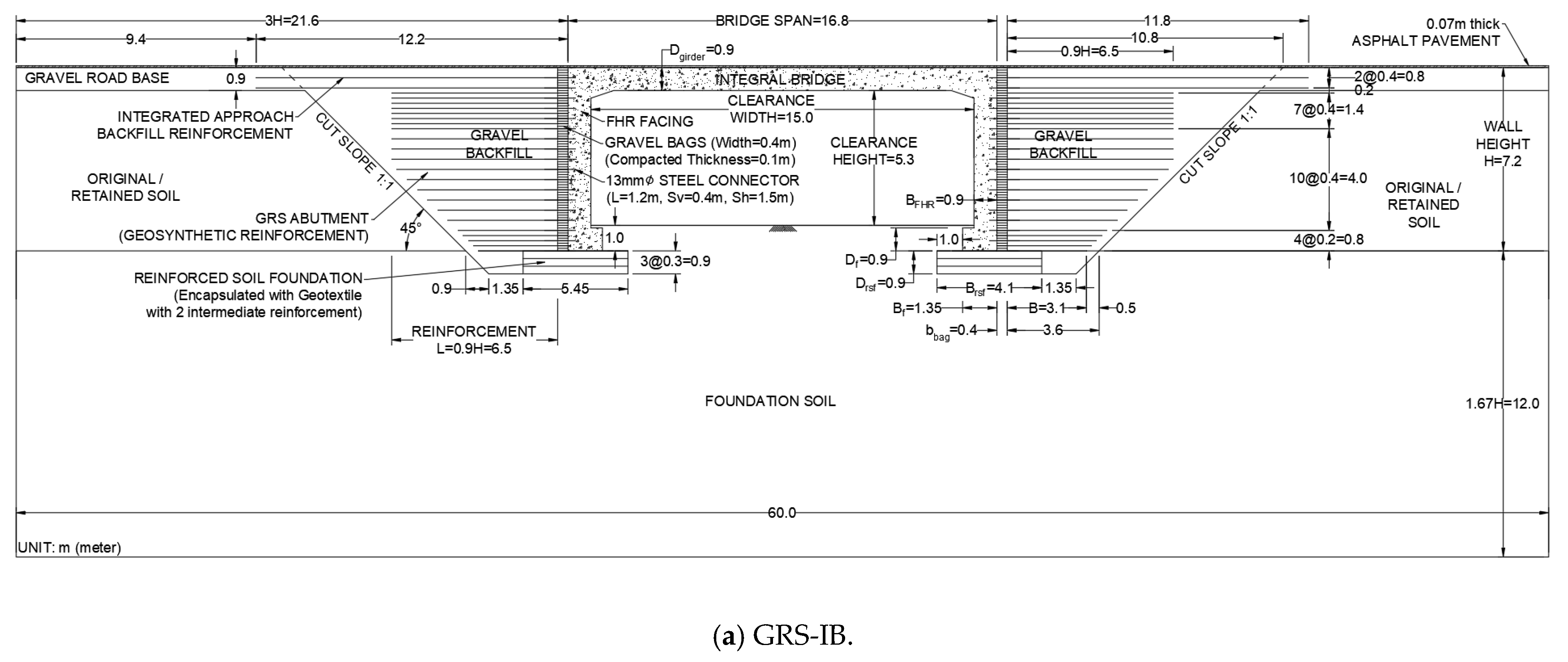
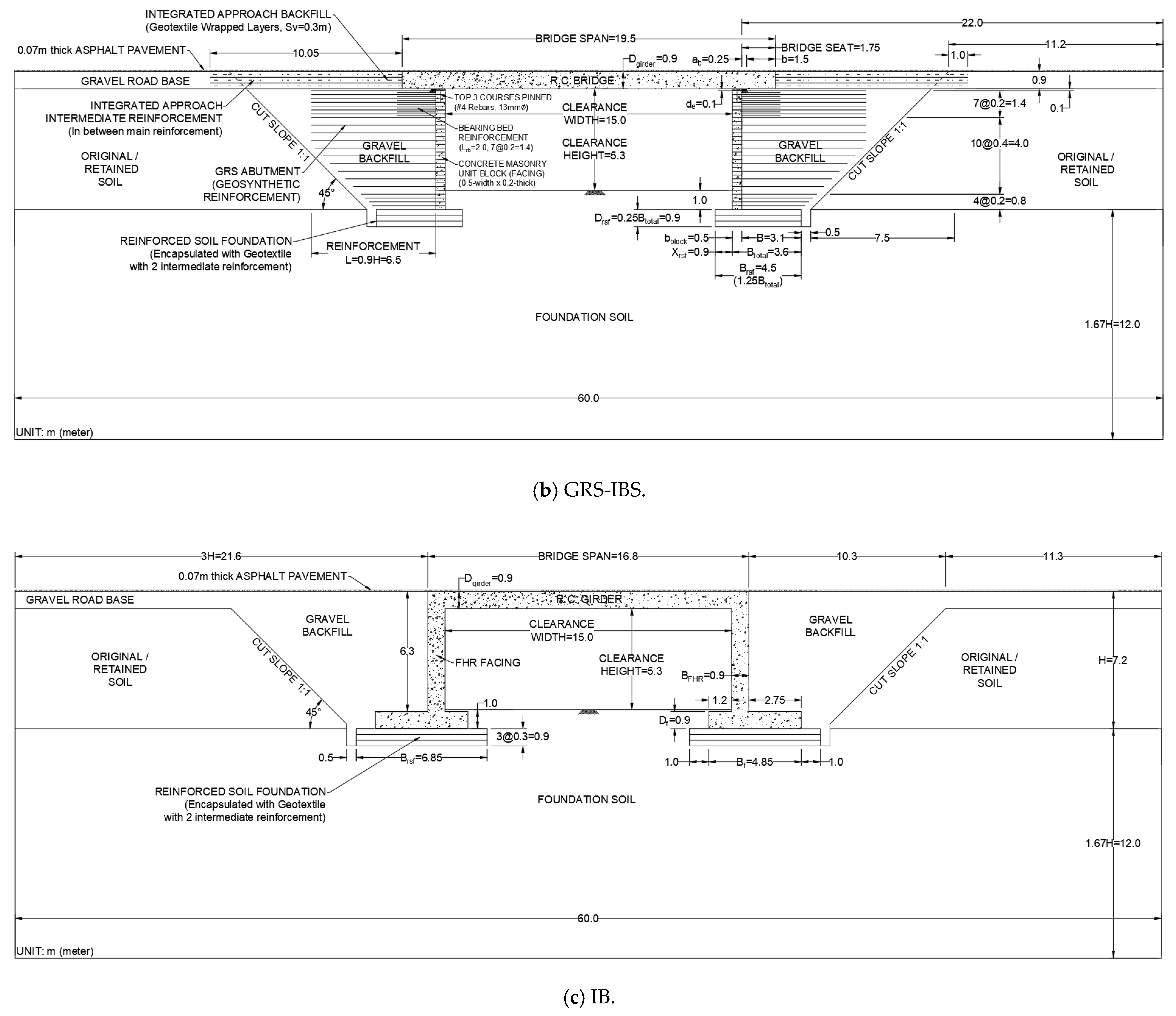

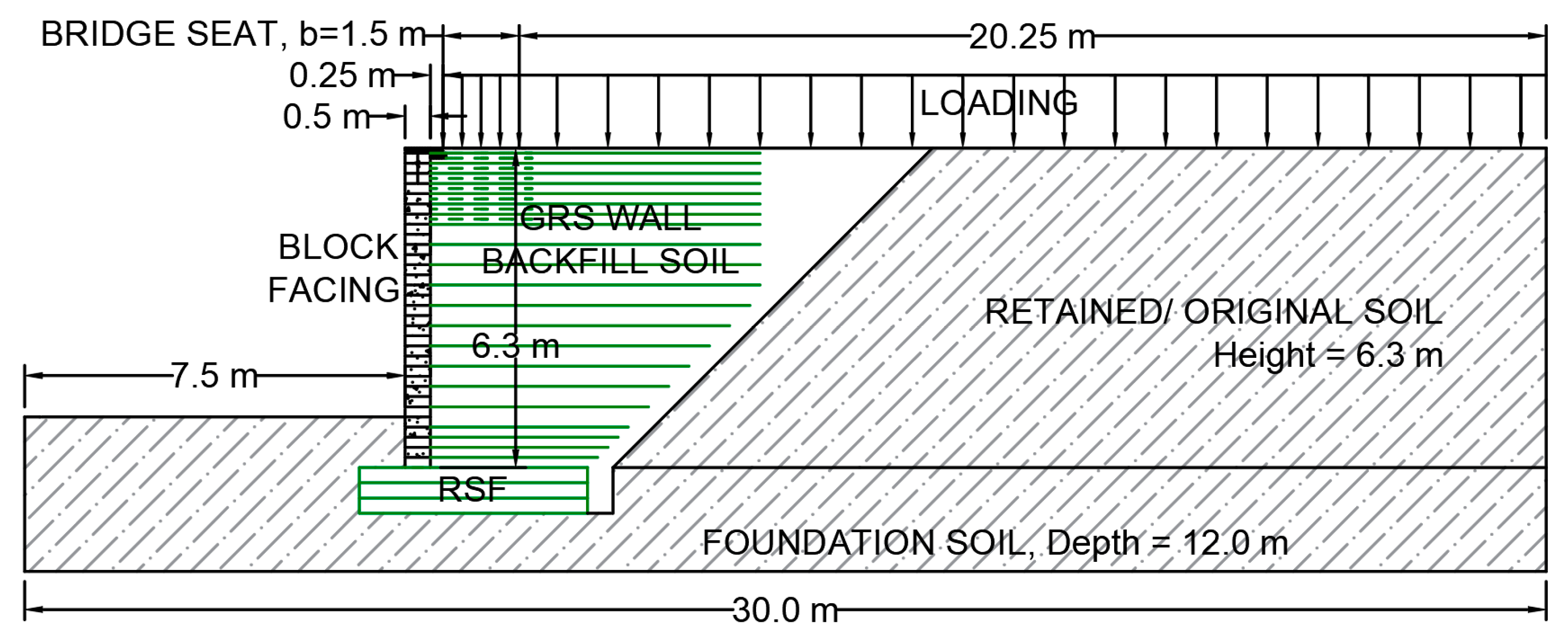

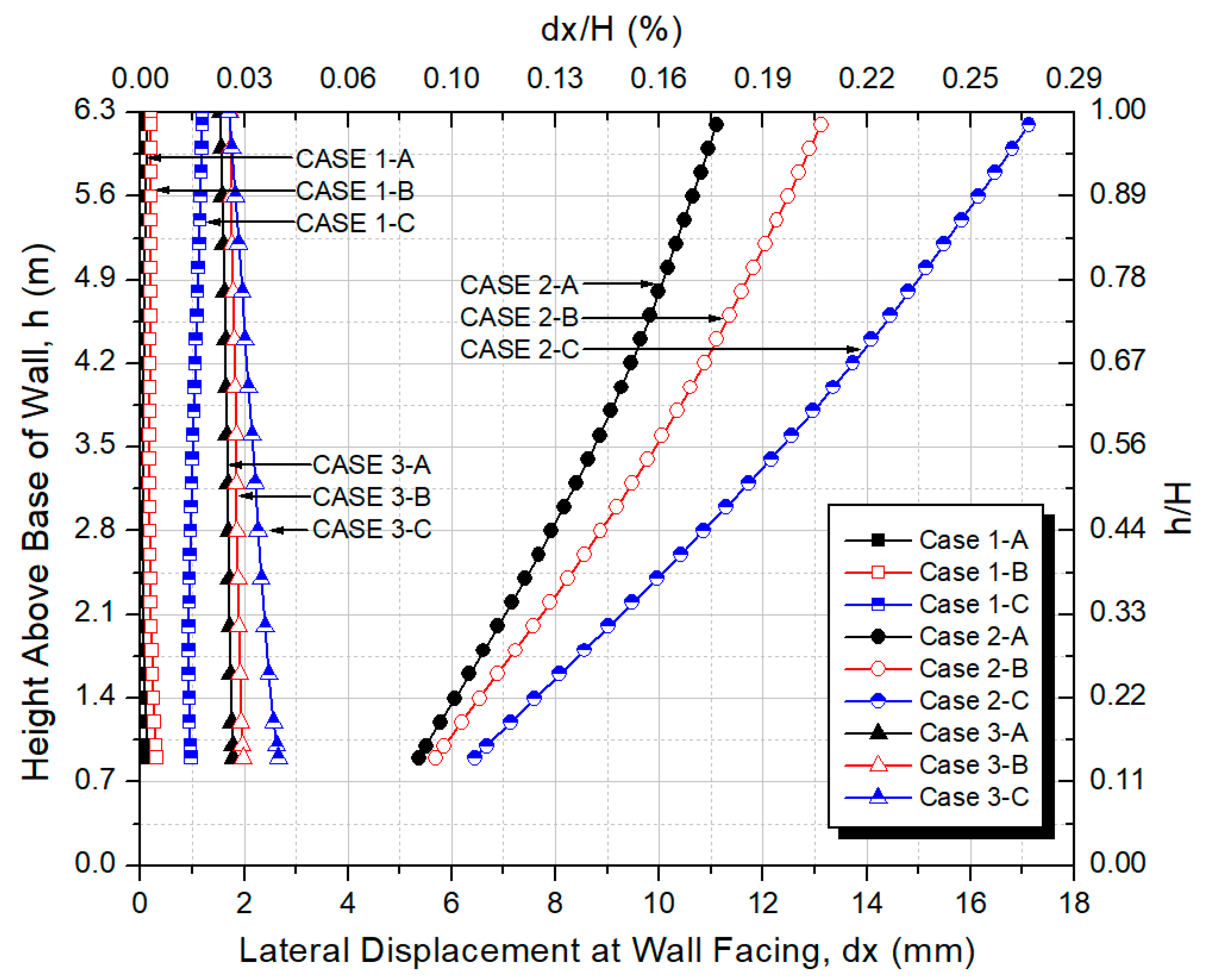
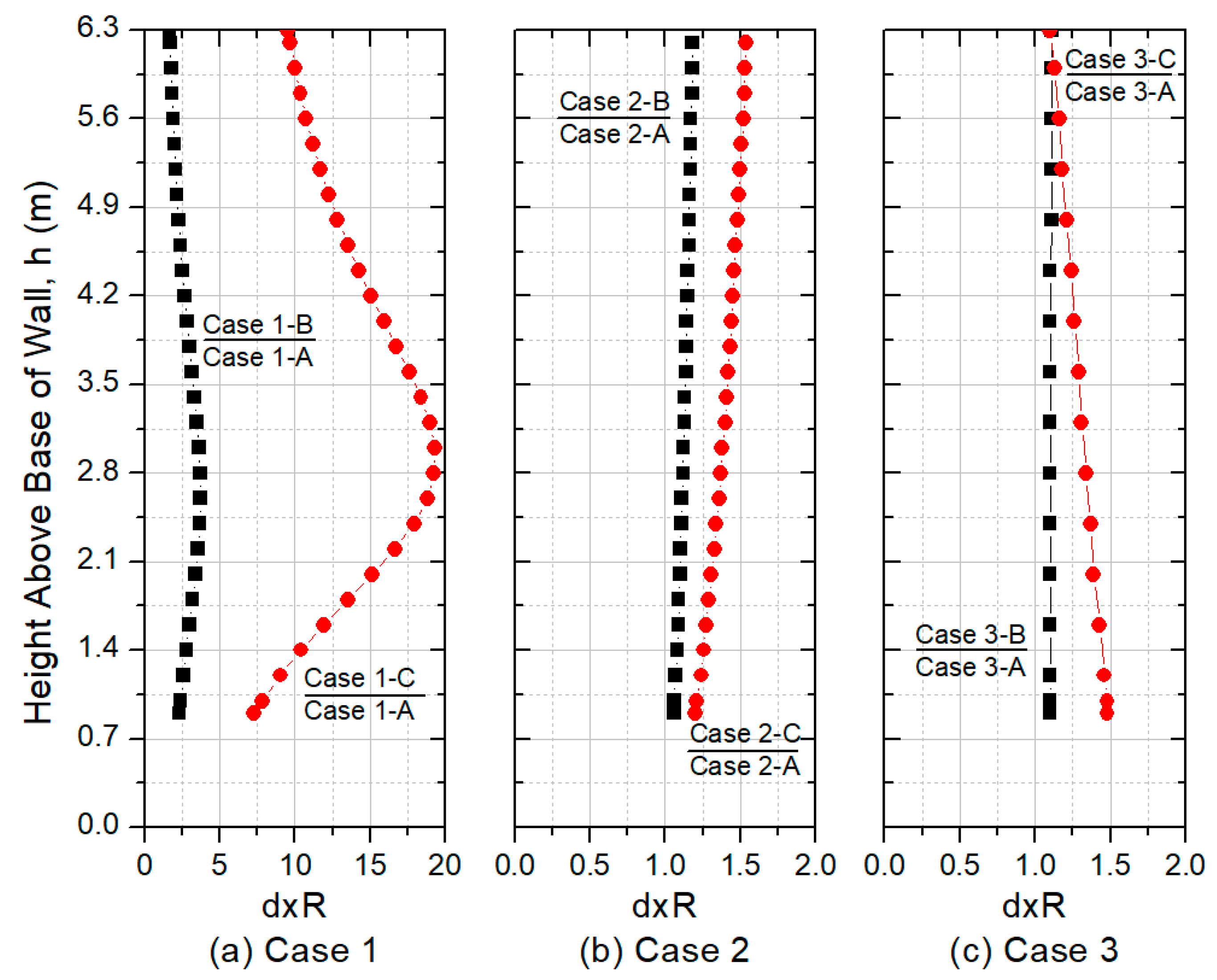
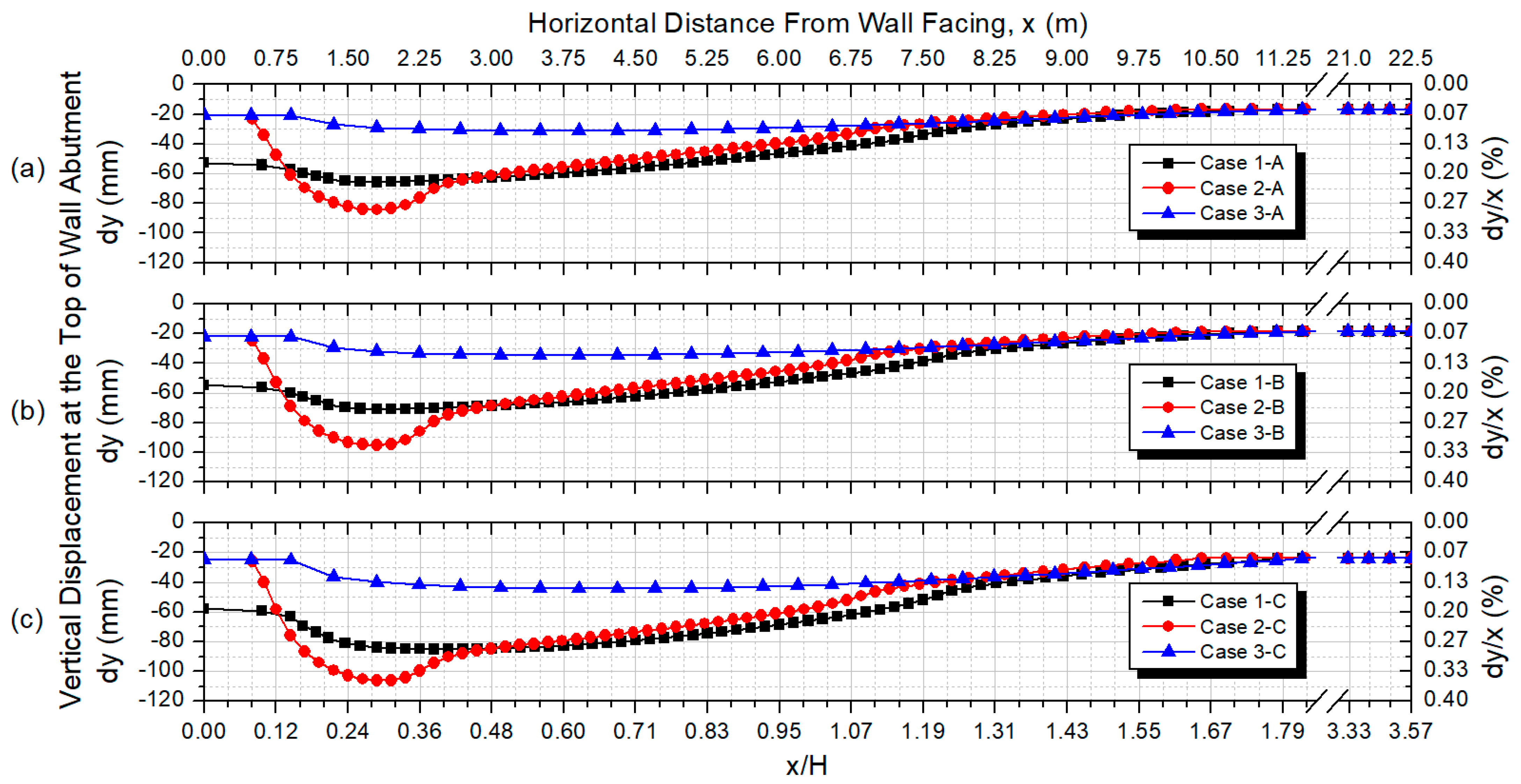
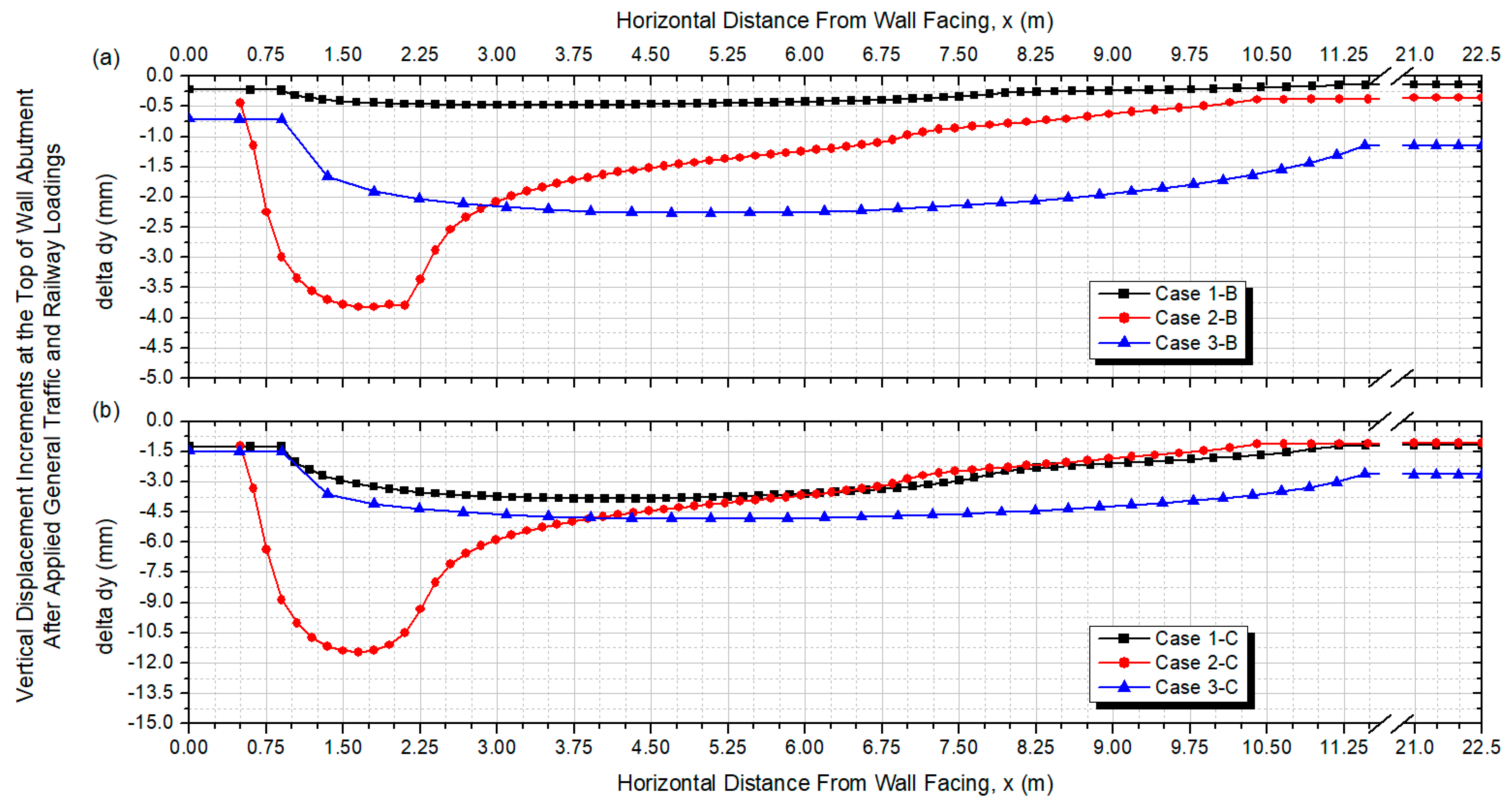
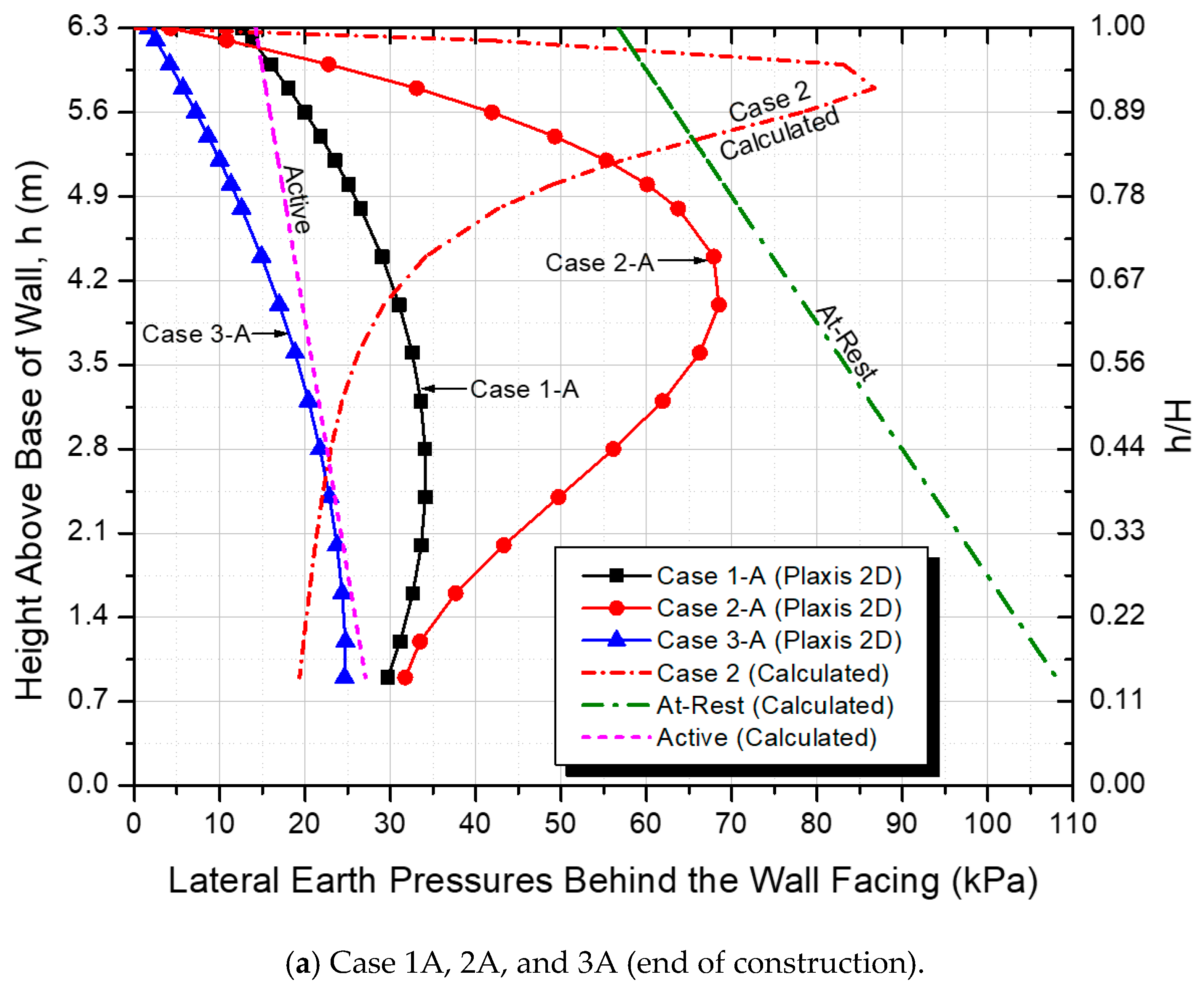

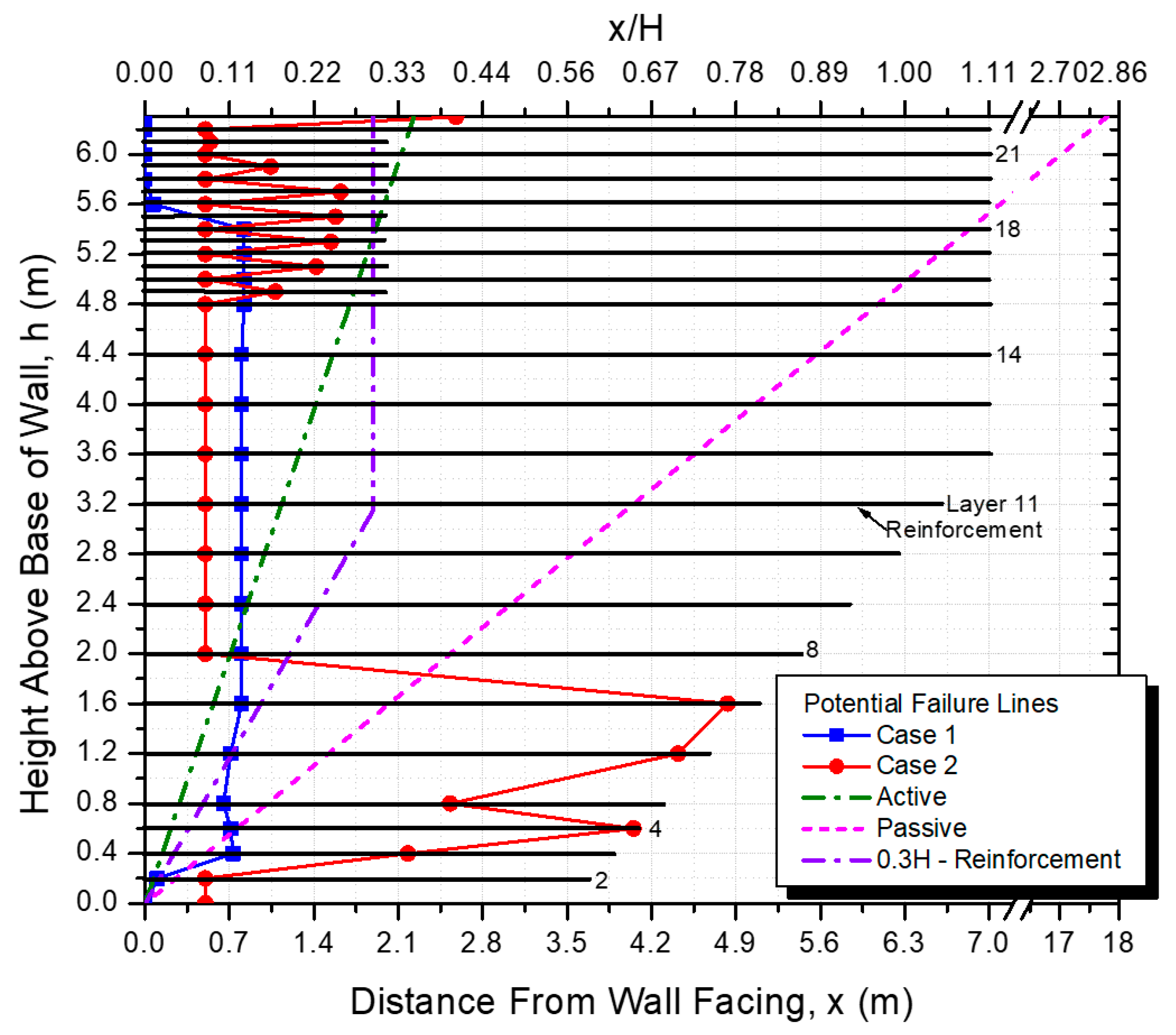

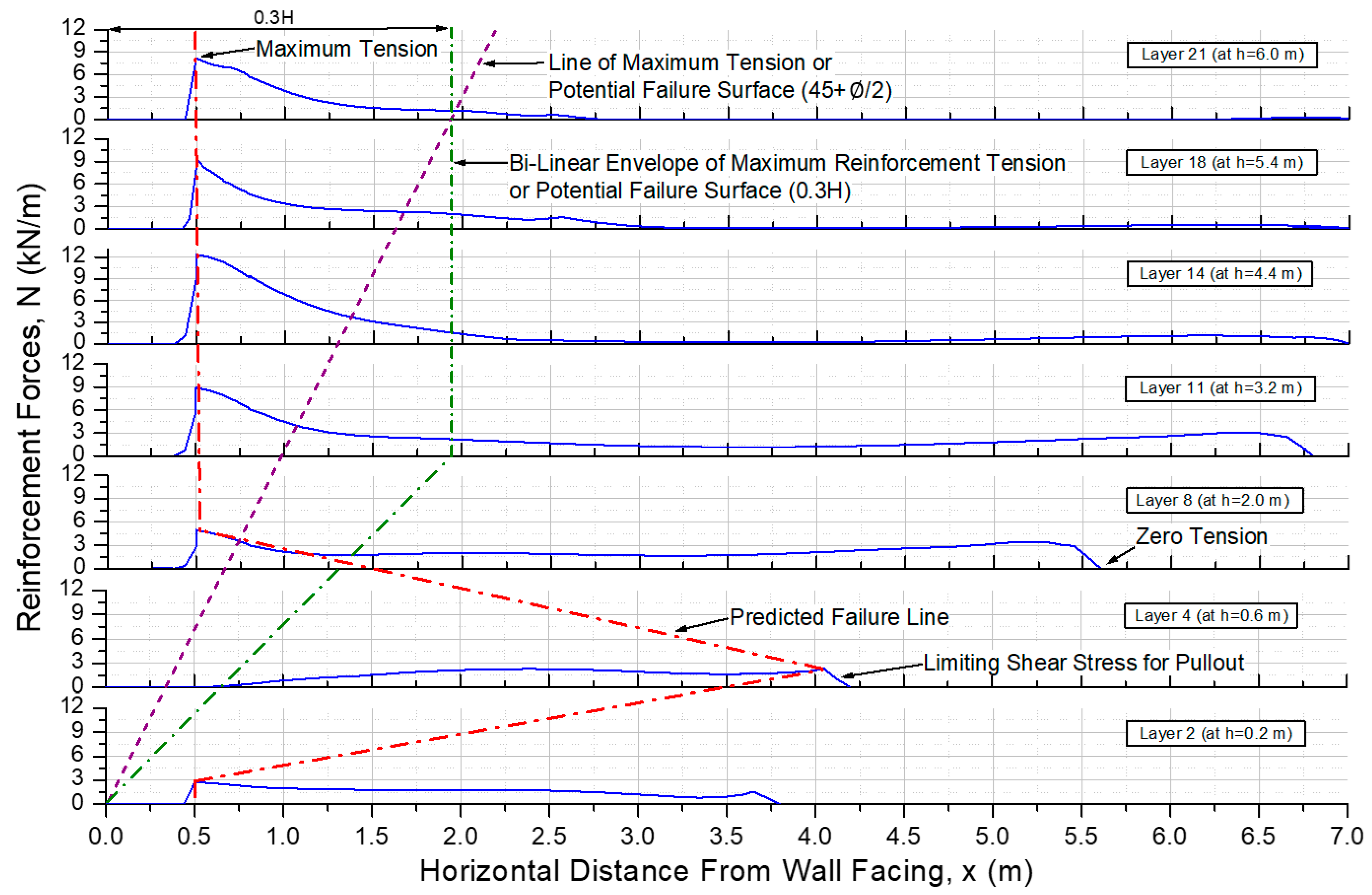
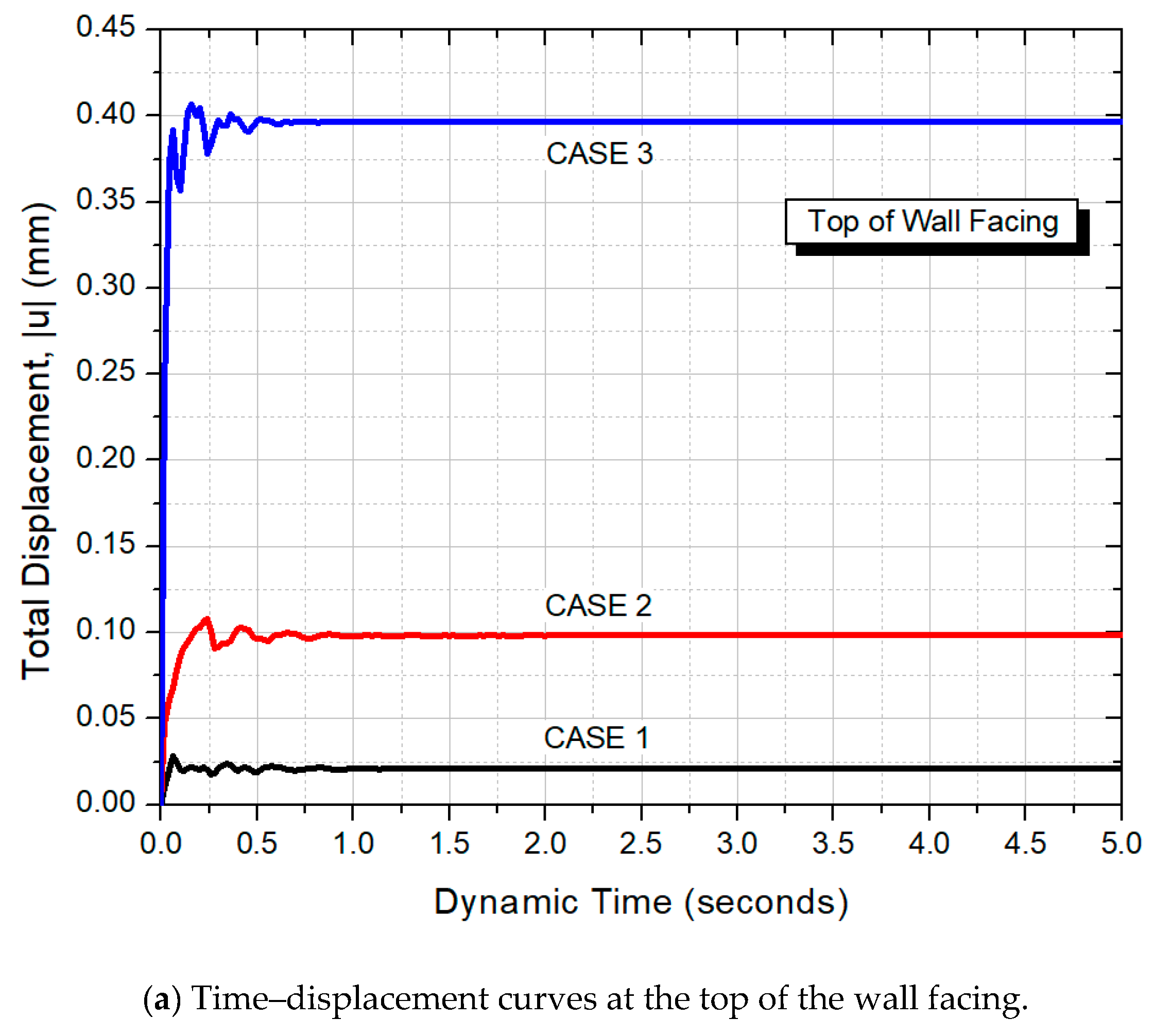

| Parameters | Unit | Backfill Soil | Gravel Bags | Retained Soil | Foundation |
|---|---|---|---|---|---|
| Material model | - | HS | HS | LE | LE |
| Unit weight, γ | kN/m3 | 19 | 19 | 20 | 20 |
| E50ref | kN/m2 | 34.0 × 103 | 34.0 × 103 | - | - |
| E50ref | kN/m2 | 25.1 × 103 | 25.1 × 103 | - | - |
| Eurref | kN/m2 | 103.2 × 103 | 103.2 × 103 | - | - |
| E | kN/m2 | - | - | 120 × 103 | 120 × 103 |
| Power (m) | - | 0.5 | 0.5 | - | - |
| cref | kN/m2 | 20 | 20 | - | - |
| ϕ (phi) | ° | 51 | 51 | - | - |
| ψ (psi) | ° | 21 | 21 | - | - |
| ν (nu) | - | - | - | 0.2 | 0.2 |
| νur | - | 0.2 | 0.2 | - | - |
| pref | kN/m2 | 100 | 100 | - | - |
| K0nc | - | 0.2229 | 0.2229 | - | - |
| Rf | - | 0.9 | 0.9 | - | - |
| Rinter | - | 0.55 | 0.55 | 1 | 1 |
| K0,x | - | 0.5 (manual) | 0.5 (manual) | 0.5 (automatic) | 1 (automatic) |
| Parameters | Unit | FHR Facing | CMU Blocks |
|---|---|---|---|
| Material model | - | LE | LE |
| Unit weight, γ | kN/m3 | 24 | 21 |
| Elastic modulus, E | kN/m2 | 30 × 106 | 30 × 106 |
| ν (nu) | - | 0.15 | 0 |
| Rinter | - | 1 (rigid) | 1 (rigid) |
| K0,x | - | 1 (automatic) | 1 (automatic) |
| Model Cases | Case 1 | Case 2 | Case 3 |
|---|---|---|---|
| 1. Case A (end of construction) | |||
| Bridge total DL (kPa) | 167 | 100 | 167 |
| Approach backfill total DL (kPa) | 18 | 18 | 18 |
| 2. Case B (general traffic loads) | |||
| Bridge total DL + general traffic LL (kPa) | 217 | 130 | 217 |
| Approach backfill total DL + general traffic LL (kPa) | 30 | 30 | 30 |
| 3. Case C (railway loads) | |||
| Bridge total DL + rail track total DL + train LL (kPa) | 250 | 150 | 250 |
| Approach backfill total DL + rail track total DL + train LL (kPa) | 68 | 68 | 68 |
Publisher’s Note: MDPI stays neutral with regard to jurisdictional claims in published maps and institutional affiliations. |
© 2021 by the authors. Licensee MDPI, Basel, Switzerland. This article is an open access article distributed under the terms and conditions of the Creative Commons Attribution (CC BY) license (https://creativecommons.org/licenses/by/4.0/).
Share and Cite
Won, M.-S.; Langcuyan, C.P. Numerical Analyses on the Behavior of Geosynthetic-Reinforced Soil: Integral Bridge and Integrated Bridge System. Appl. Sci. 2021, 11, 8144. https://doi.org/10.3390/app11178144
Won M-S, Langcuyan CP. Numerical Analyses on the Behavior of Geosynthetic-Reinforced Soil: Integral Bridge and Integrated Bridge System. Applied Sciences. 2021; 11(17):8144. https://doi.org/10.3390/app11178144
Chicago/Turabian StyleWon, Myoung-Soo, and Christine Patinga Langcuyan. 2021. "Numerical Analyses on the Behavior of Geosynthetic-Reinforced Soil: Integral Bridge and Integrated Bridge System" Applied Sciences 11, no. 17: 8144. https://doi.org/10.3390/app11178144
APA StyleWon, M.-S., & Langcuyan, C. P. (2021). Numerical Analyses on the Behavior of Geosynthetic-Reinforced Soil: Integral Bridge and Integrated Bridge System. Applied Sciences, 11(17), 8144. https://doi.org/10.3390/app11178144






